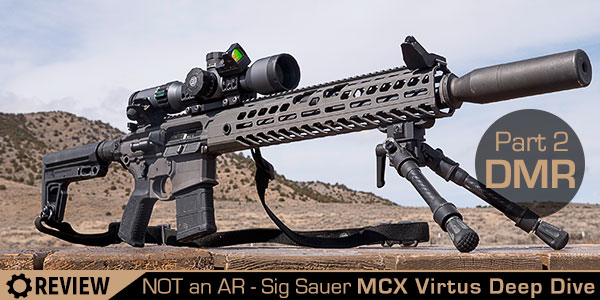 Before we dive deep into the Sig Sauer Virtus DMR review we should pause to review my background which dictates my methods and therefore what you’ll read here. I authored my first review of an AR for national publication in August of 2009, Barret’s REC 7 for Black Guns, a Harris Publication. Recently retired, it was the beginning of what my colleague Tom Beckstrand expertly referred to as a “hobby gone tragically wrong.” Written as a recently retired 20 year police career, it was the first of many. I published more than 50 articles that year for Harris alone, more than a hundred the following year and since. The law of averages alone puts the number of AR’s tested in the hundreds, probably knocking on the door of a thousand or more. The topic remains one of the most popular reviews for gun writers based on reader demand and there are a dozen more AR’s in my shop currently waiting for review. Add my testing and deployment of an AR for our SWAT team and department the previous ten years and you get a rather unique perspective. It’s a platform I am incredibly familiar with and it’s not always a favorite.
Before we dive deep into the Sig Sauer Virtus DMR review we should pause to review my background which dictates my methods and therefore what you’ll read here. I authored my first review of an AR for national publication in August of 2009, Barret’s REC 7 for Black Guns, a Harris Publication. Recently retired, it was the beginning of what my colleague Tom Beckstrand expertly referred to as a “hobby gone tragically wrong.” Written as a recently retired 20 year police career, it was the first of many. I published more than 50 articles that year for Harris alone, more than a hundred the following year and since. The law of averages alone puts the number of AR’s tested in the hundreds, probably knocking on the door of a thousand or more. The topic remains one of the most popular reviews for gun writers based on reader demand and there are a dozen more AR’s in my shop currently waiting for review. Add my testing and deployment of an AR for our SWAT team and department the previous ten years and you get a rather unique perspective. It’s a platform I am incredibly familiar with and it’s not always a favorite.
Many new offerings are interesting, some even innovative. Most are a variation on a theme, smaller, bigger, prettier, cooler, you name it, sort of a different take on the mouse trap. All said and done it’s just another AR with different clothes. Since my reviews are generally about what they do, it’s possible to continue writing about the thousandth variation on the same rifle for the thousandth time. That’s my job, to tell you what it does so you can make a decision, less editorial, more testing, more information, not always the case in magazine or web reviews. Occasionally something different comes along, especially when you look past the outer layer. So, with that as background let’s jump into Sig’s MCX Virtus DMR.
It’s not an AR!
 Sig Sauer’s MCX Virtus is one of those rifles. It’s not an AR, but it looks like one and mostly feels like one; it just does not really operate like most. It has no buffer tube so the stocks fold and you can use it folded with half a dozen different designs. It’s a short stroke piston, not new, but Sig’s is pretty light and that’s not always the case. It’s also adjustable for suppressors. More importantly it’s built as a complete system. So nope, you can’t jump on the Internet and order accessories by the boat load, or generally drop into the local shop and get accessories. Most everything is proprietary and only fits the Sig MCX Virtus. Still, it all works, is tested to destruction for the military, and is available at a competitive price to similar systems, almost half the cost of some.
Sig Sauer’s MCX Virtus is one of those rifles. It’s not an AR, but it looks like one and mostly feels like one; it just does not really operate like most. It has no buffer tube so the stocks fold and you can use it folded with half a dozen different designs. It’s a short stroke piston, not new, but Sig’s is pretty light and that’s not always the case. It’s also adjustable for suppressors. More importantly it’s built as a complete system. So nope, you can’t jump on the Internet and order accessories by the boat load, or generally drop into the local shop and get accessories. Most everything is proprietary and only fits the Sig MCX Virtus. Still, it all works, is tested to destruction for the military, and is available at a competitive price to similar systems, almost half the cost of some.
The world has become modular, especially for our Special Missions Units. That’s the reason the MCX Virtus was developed and why I am writing this series. Sig Sauer has really mastered the modular concept and you just cannot cover it in typical 1700 word feature or your more common “drive by” review. More importantly, Sig facilitated my actual test of the system, something other manufacturers generally won’t do, an advantage to my having a manufacturing license and an SOT (Special Occupational Tax). To be honest, the MCX modularity isn’t new by any means, nor the first, just the best applied to date and most available. My first article was on the 11” SBR, about perfect for self-defense and professional use. This time we head the other direction and cover the DMR (Designated Marksmen’s Rifle).
Sig Sauer Virtus DMR in 5.56mm NATO
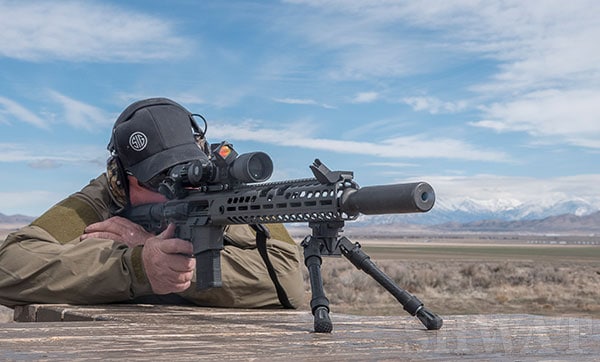
This was the initial configuration tested during the Sig Sauer Media event held at the Sig Academy in New Hampshire last August. Ironically it was almost to the day of my first AR review in 2009. Using a 16”1:7 twist barrel and SRD556 QD suppressor it was equipped with a Sig Sauer Optics Tango 6 1-6 power scope. Reticle was a BDC we zeroed at 100 yards. Hand Guard is roughly 15” covering all of the barrel. M-Lok throughout provides all the accessory space you need, stock was what comes with the Virtus. Configured this way it’s pretty light and when I hit the 600 yard target 7 out of ten times on my first (and only) attempt it was plenty accurate. Getting it back home it was the same, plenty accurate out to 500 meters and the BDC was good with both 77 grain Sig Sauer Ammunition and Black Hills 77 TMK.
Time, Time on the Range
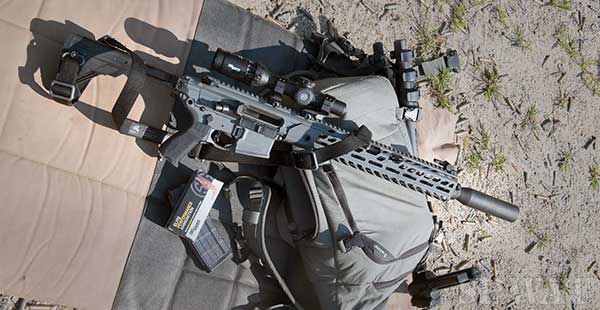 Six power is probably fine for most, just not enough for me, especially given the range capability of the 16” barrel. Typical uninformed and mostly parroted punditry makes it a 300 meter gun. Well, years of using 16” AR’s coupled with Buck Doyle’s training from Follow Through Consulting has proven that to be complete BS. Just a couple weeks ago I took an 11” carbine out to almost 500 yards hitting consistently on silhouette targets in 15 to 20 mph winds. Loaded with the right ammunition, this 16” version is a 600 meter rifle, argued by many, none of them willing to let me test it on them. Funny how that works, it’s always much easier to talk about effectiveness at range then test it.
Six power is probably fine for most, just not enough for me, especially given the range capability of the 16” barrel. Typical uninformed and mostly parroted punditry makes it a 300 meter gun. Well, years of using 16” AR’s coupled with Buck Doyle’s training from Follow Through Consulting has proven that to be complete BS. Just a couple weeks ago I took an 11” carbine out to almost 500 yards hitting consistently on silhouette targets in 15 to 20 mph winds. Loaded with the right ammunition, this 16” version is a 600 meter rifle, argued by many, none of them willing to let me test it on them. Funny how that works, it’s always much easier to talk about effectiveness at range then test it.
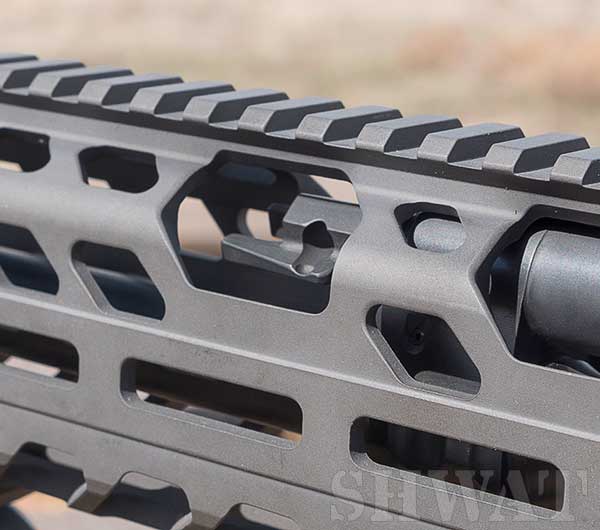
So, more power was needed and The Tango 6 was swapped out for a Nightforce ATACR 4-16 with a Horus T3 reticle. It stayed on the DMR for a while until another article netted a Tango 6 3-18 x 44mm with the DEV-L reticle. Built like a tank it’s no light weight, but it is a great scope and a perfect match on this rifle. Mounted in my Spuhr ISMS, it sits low to the bore giving a solid cheek weld using the standard Virtus stock. With their previous version using a buffer tube I took an LMT SOPMOD and filed the front down a bit to lock in at the closest position, about perfect for precision work.
Accuracy with the Sig Sauer Virtus DMR ranged from precision rifle-like to excellent in general. Measuring less than half an inch, my best group was accomplished using Sig Sauer’s 77 grain. I’m not sure I have produced a group using this configuration that reached an inch; most were between .60 and .75 inches. Black Hills 77 grain TMK was almost as accurate, and at the other end their 55 grain TSX was equally so. Interesting for sure, groups always get peoples tummy tickled and range warriors love them. Given that dot targets seldom shoot at you from 100 yards, what really counts is what it does at range from natural positions, and it excels there too.
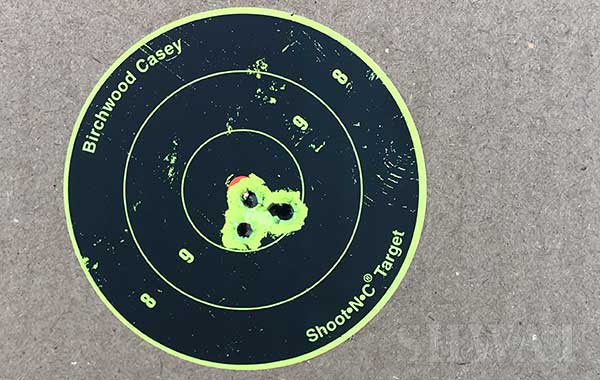 Shooting from the hood of the FJ using a bag, I loaded the Virtus DMR with Black Hills 69 grain TMK. It was fantastic out to 500 meters; beyond that the 77 grain TMK ruled. Other 77 grain ammo was fine, just kind of anemic by comparison to the Black Hills load. Later we benefitted from a handload we worked up using the Hornady 53 grain VMAX. At 3200 FPS from this 16” barrel, it is a flat out laser to 300 meters. Using a Boat Tail it’s .291 (G1) BC is excellent for bullets in this weight range. It’s turning out to be the perfect Coyote load, two taken so far by my partner using the same barrel length. Light recoiling and quiet with the SRDQD556 suppressor, it is a truly nice match. I also had fantastic success using Black Hills with the Hornady 60 grain VMAX and 55 grain TSX. All of it was pretty solid out to 400 meters, the higher weights at longer ranges. On a good day I could get 6 of 10 on the 12” steel at 700 meters with the 77 grain TMK and 53 and 60 grain VMAX loads pretty easily. Not bad for a 300 meter rifle.
Shooting from the hood of the FJ using a bag, I loaded the Virtus DMR with Black Hills 69 grain TMK. It was fantastic out to 500 meters; beyond that the 77 grain TMK ruled. Other 77 grain ammo was fine, just kind of anemic by comparison to the Black Hills load. Later we benefitted from a handload we worked up using the Hornady 53 grain VMAX. At 3200 FPS from this 16” barrel, it is a flat out laser to 300 meters. Using a Boat Tail it’s .291 (G1) BC is excellent for bullets in this weight range. It’s turning out to be the perfect Coyote load, two taken so far by my partner using the same barrel length. Light recoiling and quiet with the SRDQD556 suppressor, it is a truly nice match. I also had fantastic success using Black Hills with the Hornady 60 grain VMAX and 55 grain TSX. All of it was pretty solid out to 400 meters, the higher weights at longer ranges. On a good day I could get 6 of 10 on the 12” steel at 700 meters with the 77 grain TMK and 53 and 60 grain VMAX loads pretty easily. Not bad for a 300 meter rifle.
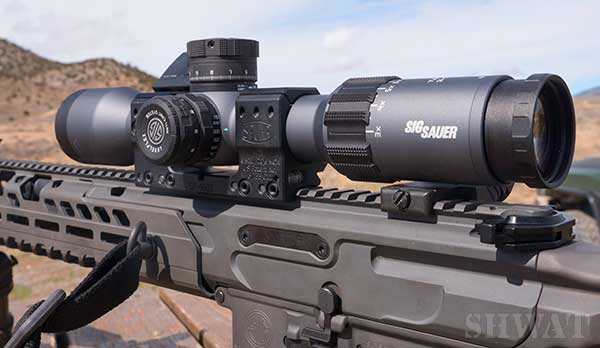
Sig Sauer’s Tango 6 line is top tier and this 3-18 is an excellent scope. With countless hours on the T3, it took a minute to get used to the DEV-L, but once dialed in it was just as fast. So if Horus is not your thing this is an excellent alternative. Glass is excellent, clear, bright during the day and handled glare pretty well. Most of my shooting has been in the winter and at my range the sun is low and in your face much of the day. The optic was as good as most in general, add the included sunshade and it was excellent. Never used the lighted reticle, typical for me, but the Level Plex internal digital level is slick. Level is critical on smaller targets at range and this made life easy. Just push the button and follow the arrows. It turns off automatically and Motac, or ‘motion activation’ seemed to work just fine. You can zero the knobs and lock them down easily. I swap scopes frequently, and being able to lock the turret down without zeroing is nice. Seldom turning knobs, these days it’s just zero and forget but you can set a hard stop if needed. Lines are easy to see without my glasses, adjustments are tactile and audible. The only real drawback is the weight. Not a huge concern for me but if you are lugging this rifle around in the back country you may want to go with the new Leupold Mark5 HD, or the Nightforce ATACR 4-16, both are available with T3 reticles and weigh a bunch less.
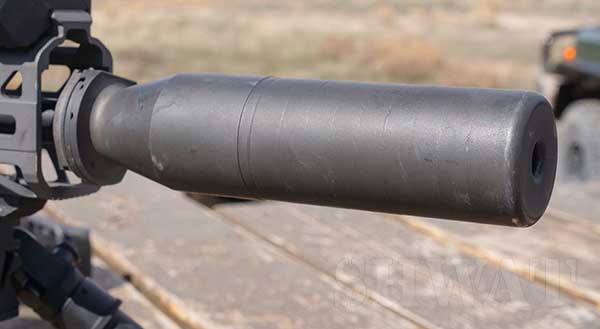 Sig Sauer suppressors have been a really nice surprise. As conventional suppressors go they are quiet and have less back pressure than most without being heavy. The QD system is robust, although I am not sold on the whole locking thing. It seems most people break that off pretty quickly and it’s kind of a pain to need a wrench to remove it. Removing it during a rather ugly weather day on the range I snapped off that “pall” on the lock. Still works great, never comes loose, but it will bother some. Replacing it is a nightmare and most people have to send it back so just be aware. Sad, since it’s a simple fix, I cannot even get them to send me one as a Title II manufacturer where it’s perfectly legal for me to have “suppressor parts.”
Sig Sauer suppressors have been a really nice surprise. As conventional suppressors go they are quiet and have less back pressure than most without being heavy. The QD system is robust, although I am not sold on the whole locking thing. It seems most people break that off pretty quickly and it’s kind of a pain to need a wrench to remove it. Removing it during a rather ugly weather day on the range I snapped off that “pall” on the lock. Still works great, never comes loose, but it will bother some. Replacing it is a nightmare and most people have to send it back so just be aware. Sad, since it’s a simple fix, I cannot even get them to send me one as a Title II manufacturer where it’s perfectly legal for me to have “suppressor parts.”
Sig Sauer uses their proprietary bevel on the barrel requiring an adapter, but to be honest it works fine and generally comes with the rifle. I have used several suppressors on this rifle and the SRDQD556 suppressor on others. For duty work you can replace the “brake” on the end with a flash hider pretty easily. Excess gas is better than most with quality ammunition. Maybe the best part is the price. Retail on this can is $750.00, in this market; they are going for closer to $600.00 in some places. Want a real bargain? Pick up the Direct Thread SRD556. It’s $150.00 less and is fantastic, maybe the best buy in a suppressor today. We picked one up and have used it on several rifles. It’s light weight, quiet, not too back pressure intensive and works on any rifle, not just the Sig Sauer.
Final Thoughts

Built as a DMR, the Sig MCX Virtus is one of the most fun configurations for me as I remain primarily a long range shooter. I shoot everything but when it’s fun time on the range its mostly 300-1000 meters with some sort of long gun. The fact you can fold the stock and pack it is a bonus. Reliability has been flawless; no real idea how much ammunition I have through it to this point, a lot, and it’s yet to malfunction. It shoots pretty clean with quality ammunition even suppressed. This Virtus has, for the most part, relegated most of my 16” or longer 5.56mm rifles to the safe or shelf, and that’s saying a lot for me. Whether whacking steel at range or Coyotes a bit closer, this DMR fits the name with ease. Remove the scope and suppressor and you have a light weight 16” do-it-all carbine. For most, this is the starting point for this system, not tax stamps, but either way it is one hell of a rifle.
Specifications: Sig Sauer MCX Virtus
Caliber/Gauge: 300 BLK / 5.56 NATO
Receiver Set Sig Sauer MCX Virtus
Barrel: 5.5 inches – 16.5 Inches
OA Length: 19 Inches (shortest), 35 inches as DMR
Weight: 8 to 9 pounds depending on configuration
Sights: Flat Top / Accepts rail mounted sights and optics.
Stocks/Grips: Sig Sauer MCX Virtus
Action: Semi-Automatic / Rotating Bolt / Short Stroke Piston
Finish: Cerakote
Capacity: Accepts AR15 based 5.56mm or 300 BLK magazines
Price: $2727.00 for base rifle, $15,000.00 (estimate) total cost including barrels, suppressor, optics, case, everything but the Rattler upper.

